The ‘Rocky’ franchise and the real fight game
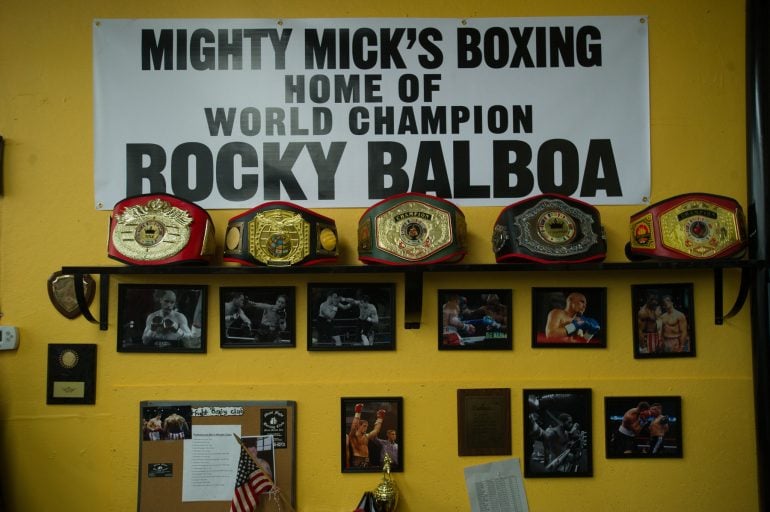

(L to R) Michael B. Jordan as Adonis Johnson, Gabriel Rosado as Leo “The Lion” Sporino and Shawn Clark as Referee #2 in Metro-Goldwyn-Mayer Pictures’, Warner Bros. Pictures’ and New Line Cinema’s drama “Creed,” a Warner Bros. Pictures release. Photo: Barry Wetcher
The imminent release of the movie “Creed” has everyone in a “Rocky” mood so we thought this would be a perfect time to review the most famous boxing franchise in movie history from the angle of a real punch rather than a Hollywood one.
Sylvester Stallone, now 69 years old, has wisely decided to put his cinematic fighting days behind him to mentor a new boxing prot├®g├® played by Michael B. Jordan. “Creed” is a spin-off which will see Stallone reprise his role as Rocky Balboa, only this time as trainer to one Adonis Johnson, the son of former rival and close friend Apollo Creed.
The chief antagonist for Johnson will be “Pretty” Ricky Conlan, who is really two-time light heavyweight title challenger Tony Bellew. The Liverpool-based puncher is by no means the first fighter to be linked to this series of films which stretches back to the days when Muhammad Ali was the undisputed heavyweight champion of the world.
For almost 40 years, “The Italian Stallion” and his onscreen wars with Apollo Creed, Clubber Lang, Ivan Drago, Tommy Gunn and Mason Dixon have crossed over into real fighter territory, with a host of boxing luminaries taking part in one or several of the six completed films.
The following is a list of the movies in chronological order accompanied by direct or indirect links to real fighters or the sport itself.
Enjoy. “Yo Adrian!”
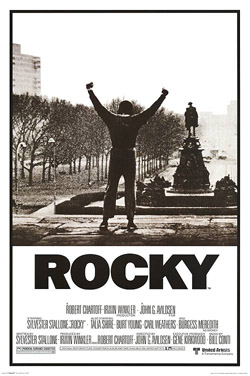 Rocky (1976)
Rocky (1976)
Only seconds into the first, and best, movie of the franchise we get a glimpse of a real fighter. Pedro Lovell, who plays Rocky knockout victim Spider Rico, was a heavyweight contender in the seventies. In January 1976, Lovell took a 17-1-1 (15 knockouts) record into a high-profile bout with future heavyweight titleholder Ken Norton and was stopped in five rounds. Norton was actually considered for the role of Rocky’s nemesis, Apollo Creed, before it went to former American football player Carl Weathers. Remarkably, Lovell would reprise his role some 30 years after working on the original, when he played a restaurant hand in Rocky Balboa.
Burgess Meredith, who plays the unforgettable role of Rocky’s trainer, Mickey Goldmill, refers to a fictitious fight in which he knocked his opponent out of the ring the same night that Luis Angel Firpo knocked Jack Dempsey out of the ring in a losing effort (Sept. 14, 1923).
Apollo Creed’s trainer, Duke, played by Tony Burton, was an ex-pro whose final contest was against LaMar Clark, who stopped him in four rounds. Clark’s final opponent was Muhammad Ali (then Cassius Clay) who stopped him in two. Burton, a far better actor than he was a fighter, is a recurring character in all six Rocky movies. Unfortunately, he will not make an appearance in “Creed.”
Burt Young, who played Rocky’s brother-in-law, Paulie, is also listed as having been a professional fighter but efforts to locate a ring record proved fruitless, even when searching under the actor’s birth name of Richard Morea. Can anyone help? Like Burton, and obviously Stallone, he is the only character to make an appearance in all six movies. A fine actor, he is also a no-show in “Creed.”
A poster of Rocky Marciano adorns the wall of the fictitious fighter’s apartment.
The late boxing trainer Al Silvani plays himself in the movie and is credited as “Cut Man” for Rocky. Silvani, a New Yorker, trained Nino Benvenuti in the late ’60s and also worked Floyd Patterson’s corner during his infamous 1965 bout against Muhammad Ali. Silvani can be seen stretching Patterson’s back between rounds, when a sacroiliac condition flared up during that contest. He reprised his role in Rocky II and III.
The finale between Rocky and Apollo takes place at the Philadelphia Spectrum on Jan. 1, 1976. The Spectrum was a boxing hotbed for middleweights during this ’70s and showcased Marvelous Marvin Hagler, Emile Griffith, Eddie Mustafa Muhammad, Bennie Briscoe and Eugene Hart, among others.
Former heavyweight champion of the world Joe Frazier, playing himself, is introduced to the crowd prior to the movie’s main event and has a playful exchange with Apollo Creed. During the training sequences in the movie, Rocky works out at a slaughterhouse, punching cow carcasses, just like Frazier did in the early stages of his own real-life boxing journey.
Rocky runs up the steps towards the Philadelphia museum. Guess who once did that? “Smokin” Joe Frazier.
Veteran official Lou Filippo, best known for being the only judge to score in favor of Marvelous Marvin Hagler over Sugar Ray Leonard in 1987, refereed Creed-Balboa. He would also referee in the next four sequels.
As most fight fans know, Stallone was inspired to write the “Rocky” script after viewing Muhammad Ali’s heavyweight title defense against Chuck Wepner in March 1975. Despite Ali being a vastly superior fighter, Wepner dropped the champion and made it all the way to the 15th round before being stopped. This inspiration became a great source of controversy, decades later, when Wepner decided to take Stallone to court claiming that the actor had persistently referenced his story but never paid him. They settled out of court in 2006, with Wepner receiving an undisclosed sum.
Muhammad Ali appeared with Stallone at the 1976 Oscars at which the movie won an Academy Award for Best Picture. Footage of Stallone at this event was included in the opening of “Rocky III.”
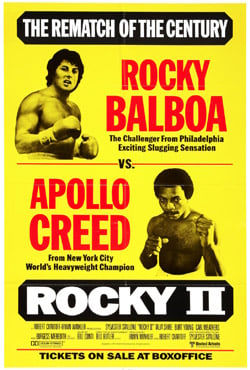 Rocky II (1979)
Rocky II (1979)
The first sequel sees the introduction of the RING championship belt which would become a mainstay for the remainder of the series. In the scene where Apollo Creed makes his intentions clear of pursuing a rematch with Rocky, the belt can be seen framed behind him in his office. “Rocky” aficionados will remember the quote, “Man, I won but I didn’t beat him.”
Former lightweight world champion Roberto Duran, already a boxing legend, made a cameo in this movie as a sparring partner for Rocky. An agreement was likely reached for this appearance at the June 1978 heavyweight title fight between Ken Norton and Larry Holmes. Both Stallone and Duran were clearly visible ringside, seated next to actor Chevy Chase.
Chuck Wepner was also set to appear as a sparring partner but his part was cut after rehearsals didn’t live up to expectations.
Rocky has trouble with the peripheral vision out of his right eye, which is exposed by a concerned Mickey. The legendary Joe Frazier entered the ring against Muhammad Ali for their third fight in Manila with very limited vision out of his left eye and, unlike Rocky, was unable to fully recover from this handicap. That’s Hollywood.
Renowned artist LeRoy Neiman can be seen painting a picture of Apollo during a training sequence. Neiman had been around the boxing business for several years and his portraits and drawings were very valuable. He was ringside for the first Ali-Frazier fight, among others, and his work is also featured during the closing credits of “Rocky III.” He plays a ring announcer in Rocky III, IV and V and has a credit in Rocky Balboa.
The memorable chicken chasing sequence featuring Mickey and Rocky was apparently inspired by old-style training which took place centuries ago. “Creed” recreates the scene in a nostalgic nod to this movie.
While the double knockdown in the closing seconds of the Creed-Balboa rematch cannot be linked to a well-known fight, it does happen. The dramatic ending in this fictional matchup has never occurred in a heavyweight title fight before or since — but it would be fun if it did.
 Rocky III (1982)
Rocky III (1982)
The RING championship belt is the first thing the viewer sees when the movie begins. The title animation “ROCKY III” rolls over the belt prior to the flashback sequence of “Rocky II.”
The official theme song for the movie was “Eye of the Tiger” by American rock band Survivor which, 33 years on, has to be one of the most widely used entrance songs in modern boxing history.
During the opening montage, which showcases Rocky’s title defenses, you can see original fight footage faded into the background. It’s filmed from a distance but, on close inspection, appears to be the first meeting between Sugar Ray Leonard and Thomas Hearns, which took place in September 1981.
In the same montage we see Rocky shoot commercials and lend his name to a candy bar. Muhammad Ali did both during the twilight years of his own career.
In another memorable scene, Rocky takes on a wrestler by the name of “Thunderlips,” played by real-life WWF legend Hulk Hogan. This clash of combatants was likely inspired by the 1976 boxer-versus-wrestler matchup between Muhammad Ali and Antonio Inoki, which took place in Japan.
In the movie Rocky is trained by former nemesis Apollo Creed. Life would imitate art years later when Micky Ward trained good friend, and former foe, Arturo Gatti prior to his final fight against Alfonso Gomez.
Mr. T plays Rocky’s new antagonist, the menacing Clubber Lang. The former Chicago nightclub bouncer, who went on to achieve international fame in “The A-Team,” worked as a bodyguard for former heavyweight champions Leon Spinks and Muhammad Ali.
Former heavyweight title challenger Earnie Shavers auditioned for the role of Clubber Lang by taking part in a pseudo sparring session with Sylvester Stallone. It didn’t end well. According to Shavers, the actor didn’t want him to hold back so he released a left hook to the body which ended both the sparring session and any hopes Shavers had of appearing in the movie.
Both of Rocky’s battles with Clubber Lang take place in New York with the second one definitely staged at Madison Square Garden. The first encounter is likely staged there too.
Acclaimed ring announcer Jimmy Lennon introduces Rocky and Lang prior to their first fight. His son, Jimmy Lennon Jr., is one of the two most prolific announcers in world boxing today. The other is obviously Michael Buffer.
Veteran referee Marty Denkin officiates Lang-Balboa II.
In the rematch, Rocky allows his opponent to punch himself out in a third round which seems to last forever. With Lang exhausted, he then opens up and scores a knockout which is very reminiscent to the ending of Muhammad Ali’s victory over George Foreman.
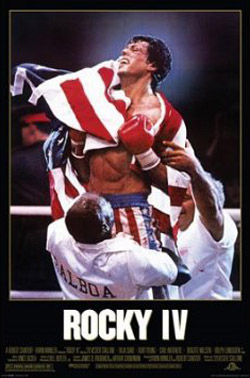 Rocky IV (1985)
Rocky IV (1985)
The sequel that predicted the future. In 1985, a professional heavyweight from the now-former Soviet Union could only get as far as the silver screen in the form of the fearsome Ivan Drago. Future champions Vitali and Wladimir Klitschko were young boys growing up there and heavyweight titles must have seemed light years away. Today, both men proudly represent their home country of Ukraine, with former heavyweight champion Vitali active in politics and Wladimir still recognized as the true king of the glamour division.
The site for the so-called exhibition bout between Creed and Drago was the MGM Grand Hotel and Casino, which is now Bally’s Las Vegas. The new MGM Grand was erected in 1993.
Up until 1985, the most flamboyant ring entrances probably involved Hector Camacho. Apollo Creed’s “Living in America” performance, complete with James Brown, was considered way over the top but somewhere in Sheffield, England, a 9-year-old Naseem Hamed had his own ideas.
The movie explores the subject of ring fatalities as the Apollo Creed character dies as the result of injuries sustained in a bout with Drago. This was a very controversial issue at the time due to the deaths of Cleveland Denny, Johnny Owen, Duk-Koo Kim and Willie Classen, all of whom had passed away following professional fights within the previous few years.
The RING heavyweight championship belt is left at Apollo Creed’s graveside by Rocky.
Ivan Drago receives an injection during a training sequence with the clear implication being that he is loading up on anabolic steroids, although that is never confirmed. Again the movie presages the future, as the use of performance enhancing drugs in boxing would flare up years later and continues to cause massive controversy to this day.
This was the first time that national anthems (American and Russian) were used in a Rocky movie. The music, the flags, and the long closeups all serve to spice up Stallone’s unapologetic propaganda machine. The Cold War, which had lasted some 44 years, was officially over in 1991. Anthems are now a regular part of big fights.
One of the commentators for Balboa-Drago is Barry Tompkins who, at that time, was calling fights for HBO.
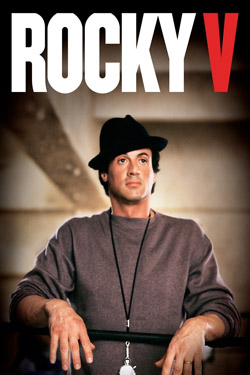 Rocky V (1990)
Rocky V (1990)
The controversial issue raised in this movie is the subject of brain damage which Rocky has sustained following years of beatings in the ring.
Rocky’s character loses the majority of his earnings and belongings in this movie, a tragedy that has befallen too many prizefighters.
This was the first time Stallone used a real professional boxer as his main rival. Tommy Morrison, who plays Tommy “Machine” Gunn, was an unbeaten contender who would go on to win a WBO heavyweight title. He shared the ring with Lennox Lewis, George Foreman, Ray Mercer and Razor Ruddock among others. He tragically passed away at the age of 44 due to HIV/AIDS.
Actual footage of Morrison’s fights was filmed and included in this movie.
Real-life heavyweight Michael Anthony Williams, who plays Union Cane, is the heavyweight champion of the world until Tommy Gunn knocks him out inside one round.
Burgess Meredith returns for a flashback sequence as Mickey and hands his beloved fighter Rocky Marciano’s cuff link as a gift. Really, Sly?
Al Bernstein makes his debut in a Rocky movie.
Referee Frank Cappuccino also makes his debut in a Rocky movie.
American actor Richard Gant does a better impersonation of Don King than Don King does of himself these days.
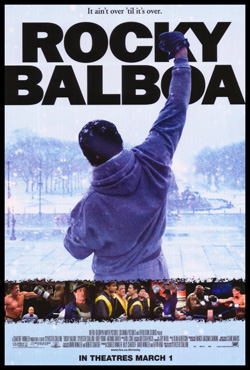 Rocky Balboa (2006)
Rocky Balboa (2006)
Instead of replicating reality, Stallone was now going well beyond the suspension of disbelief. Or was he? Just ask Bernard Hopkins if a man can still fight effectively in his 50s (Stallone was sixty, but who’s counting?)
Antonio Tarver, who plays Mason “The Line” Dixon, was the first reigning world champion to play a Rocky rival. He was the RING light heavyweight champion during filming.
Stallone’s original choice for Dixon was Roy Jones Jr., who supposedly never returned his calls.
Bert Sugar, Brian Kenny and Bernard Fernandez appear in a mock ESPN boxing show which reviews a computer fight between Dixon and Rocky. The movie links this to the Ali-Marciano fantasy matchup that was staged in 1969.
Promoter Lou DiBella made his debut in a Rocky movie
Referee Joe Cortez made his debut in a Rocky movie.
Ring announcer Michael Buffer made his debut in a Rocky movie.
Mike Tyson has a cameo appearance and improvised his own lines.
The full HBO Boxing crew — Larry Merchant, Jim Lampley and Max Kellerman — appear in this movie, as do the network’s fight format and onscreen graphics.
Real footage of Antonio Tarver fighting Glen Johnson is used as part of a highlight reel.
The end fight between Dixon and Rocky was shot using a live crowd who were attending the undisputed middleweight title rematch between Jermain Taylor and Bernard Hopkins in Las Vegas. Ironically, Hopkins would defeat Antonio Tarver soundly in the latter’s very next professional fight.
Mason Dixon wins a 10-round split decision over Rocky. Adalaide Byrd and Bill Graham scored the bout 95-94 for Dixon, with Chuck Giampa having an off-night and giving the bout to Balboa by the same score.
Tom Gray is a member of the British Boxing Writers’ Association and has contributed to various publications. Follow him on Twitter: @Tom_Gray_Boxing














